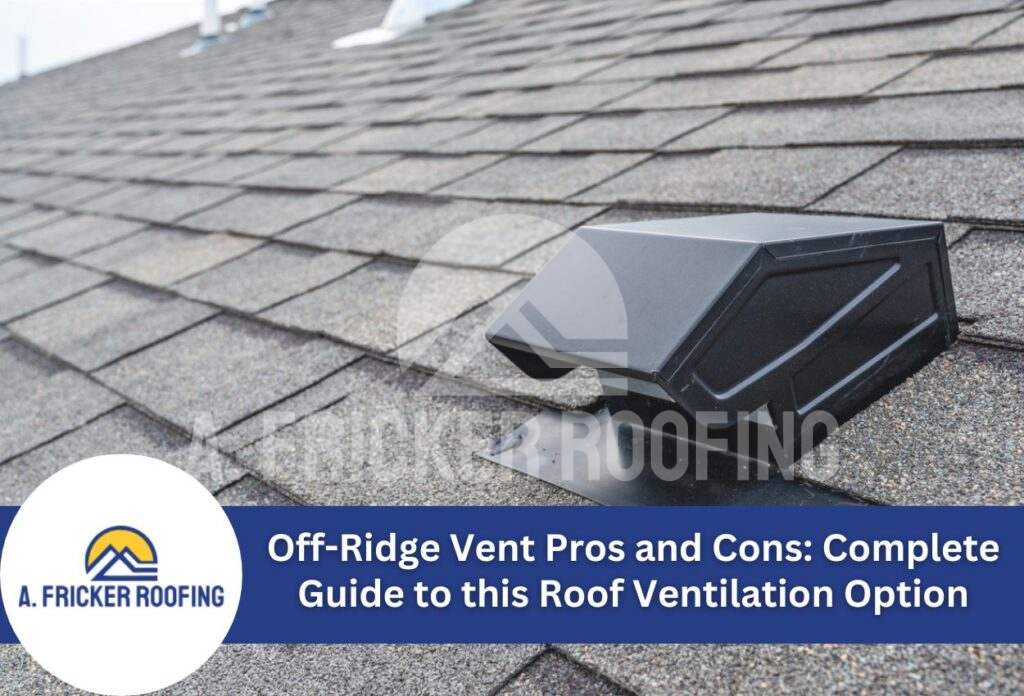Off-Ridge Vent Pros and Cons: Complete Guide to this Roof Ventilation Option

For Tulsa homeowners, attic ventilation stands as one of the most critical yet often overlooked components of a healthy roofing system. Off-ridge vents are a popular ventilation option that balances necessary function with curb appeal. These static vents are strategically installed along the roof plane, not at the peak, and allow hot, moist air to escape from the attic space while maintaining your roof’s clean lines.
Understanding the off-ridge vent pros and cons helps homeowners make decisions about their roofing systems. These vents play a vital role in extending the lifespan of your roof by reducing heat buildup that can warp shingles and damage roofing materials. Sufficient ventilation also contributes to lower energy costs during Oklahoma’s hot summers by reducing the strain on air conditioning systems.
Along with temperature regulation, effective attic airflow prevents moisture accumulation that leads to mold growth, wood rot, and insulation damage. Off-ridge vents work as part of a passive attic ventilation system, requiring no electricity while providing continuous air exchange. As static roof vent options continue to evolve in both efficiency and design, Tulsa homeowners have more choices for maintaining optimal roof performance throughout extreme weather conditions.
How Off-Ridge Vents Work: A Complete Breakdown
Off-ridge vents operate through a straightforward yet effective principle of natural convection. Positioned near but not directly on the roof’s ridge, these vents create exit points for warm air that naturally rises through the attic space. When paired with soffit or intake vents at the lower portions of the roof, they establish a continuous airflow pattern that ventilates the entire attic.
Tulsa homeowners can choose from several off-ridge vent designs to match their specific roofing configuration. Shingle-over models blend seamlessly with existing roofing materials, maintaining your home’s curb appeal while providing essential ventilation. For homes with unique architectural features, specialized off-ridge vents are available that accommodate different roof pitches and material types.
The effectiveness of off-ridge vents comes from their strategic placement along the upper portion of the roof. This positioning allows them to take advantage of both thermal buoyancy (hot air rising) and negative pressure created by wind passing over the roof surface. Unlike powered vents, these passive attic ventilation systems require no electricity or maintenance, making them a reliable, cost-effective solution for Tulsa homes facing both summer heat and winter moisture challenges.
When professionally installed, off-ridge vents provide balanced airflow that helps maintain consistent attic temperatures and humidity levels throughout Oklahoma’s varying seasons.
Key Advantages of Off-Ridge Ventilation Systems
Off-ridge ventilation systems offer Tulsa homeowners several distinct advantages that make them an attractive option for many roofing configurations. Perhaps most notably, these vents provide superior aesthetic appeal compared to their ridge-mounted counterparts. Being positioned along the roof plane rather than at the peak makes them less visually prominent from street level, preserving your home’s architectural character while still delivering essential ventilation.
The flexible installation options represent another significant benefit. For Tulsa homes with complex roof designs featuring multiple hips, valleys, or dormers, off-ridge vents can be strategically placed where conventional ridge vents cannot reach. Additionally, these vents demonstrate excellent performance in high-wind areas common during Oklahoma storm seasons, with designs specifically engineered to prevent water intrusion during driving rain.
Off-ridge vents also work exceptionally well as complementary components within a comprehensive ventilation strategy. Many Tulsa roofing professionals recommend combining them with existing soffit vents to create consistent airflow patterns. For historic homes or properties with architectural limitations that make ridge vents impractical, off-ridge solutions provide effective attic airflow.
Potential Drawbacks of Off-Ridge Vents to Consider
While off-ridge vents offer numerous benefits, Tulsa homeowners should weigh potential limitations before committing to this ventilation option. Installation complexity represents one primary consideration, as optimal placement of the vent requires careful planning and professional help. Unlike ridge vents that follow a straightforward installation path along the roof peak, off-ridge vents need precise positioning to maximize airflow efficiency while avoiding rafters and other structural elements.
Coverage requirements present another challenge. A single off-ridge vent provides ventilation for only a portion of your attic, meaning multiple units are typically necessary to achieve adequate airflow throughout the space. This can impact both installation costs and roof aesthetics. Tulsa’s climate also warrants special consideration because our extreme temperature fluctuations and seasonal storms can affect static roof vent effectiveness differently than in more moderate climates.
Long-term maintenance requirements deserve attention when comparing passive attic ventilation options. While off-ridge vents have no moving parts, they may collect debris over time and require occasional cleaning to maintain optimal performance. During Oklahoma’s severe weather events, these vents may be more susceptible to damage than ridge vents, which sit at the highest point of the roof and distribute wind pressure more evenly. A professional assessment of your specific attic configuration and ventilation needs is essential for determining whether off-ridge vents are the best vent option for your Tulsa home.
Off-Ridge vs. Other Ventilation Options: A Comprehensive Comparison
When evaluating roof ventilation systems for your Tulsa home, understanding how off-ridge vents compare to alternatives helps determine the best solution for your specific situation. Ridge vents, while excellent for continuous airflow along the entire roof peak, may not be suitable for homes with complex roof designs or short ridge lines. Off-ridge vents provide targeted ventilation in these scenarios, offering flexibility where ridge vents cannot be installed.
Power vents, while effective during extreme heat, require electricity and have mechanical components that eventually need replacement — unlike off-ridge vents that operate passively without ongoing operational costs. Soffit vents, which serve as intake ventilation, work with off-ridge vents to create a complete system. This combination is very effective in many Tulsa homes, as the soffit vents draw in cooler air while off-ridge vents expel hot, humid air.
For homes with hip roofs common in certain Tulsa neighborhoods, off-ridge vents often provide the only practical high-point exhaust option. Similarly, historic homes with distinctive architectural features benefit from the less visually intrusive profile of off-ridge vents. Overall, the ideal ventilation system depends on your roof design, attic configuration, and local climate. Many Tulsa roofing professionals recommend a balanced approach, sometimes combining multiple ventilation types to achieve sufficient airflow throughout all seasons.
Off-Ridge Vent Installation Considerations for Tulsa Homeowners
Professional installation of off-ridge vents requires careful planning and expertise for long-term performance. Proper placement is critical — professionals typically position these vents with adequate distance from other ventilation components to prevent short-circuiting airflow. Installation requires specialized tools, including roofing nailers, circular saws, and sealing materials to ensure weather-tight integration with existing roofing materials.
Tulsa’s building codes specifically address ventilation requirements, with most local regulations following the 1:300 rule: 1 square foot of ventilation for every 300 square feet of attic space. Our region’s intense summer heat and winter storm patterns mean that strategic vent positioning must account for prevailing wind directions and seasonal temperature fluctuations.
Professional installers determine the optimal number and positioning of off-ridge vents by evaluating several factors specific to your home. Attic square footage provides the baseline calculation, while roof pitch affects the efficiency of natural convection that drives passive ventilation systems. Existing ventilation components must be inventoried and assessed to ensure balanced airflow. Most Tulsa homes require between four and eight off-ridge vents, depending on attic configuration, with larger homes or complex roof designs potentially requiring additional units to achieve effective attic airflow.
How to Choose Roof Vents for Your Home
When selecting the ideal ventilation system for your Tulsa home, multiple factors need to be considered. Start with an evaluation of your roof’s configuration — homes with limited ridge space or complex architectural designs often benefit most from off-ridge vents. Next, assess your current ventilation performance by checking for signs of inadequate airflow, such as excessive attic heat, moisture damage, or ice damming during winter.
Your long-term goals also influence this decision. If energy efficiency ranks high on your priority list, a properly designed off-ridge ventilation system can significantly reduce cooling costs during Tulsa’s hot summers. For homeowners concerned with maintaining their roof’s appearance, off-ridge vents offer less visible alternatives to other ventilation options while still providing effective airflow.
The age and condition of your existing roof play crucial roles in this decision as well. Adding off-ridge vents during a scheduled roof replacement is often more cost-effective than retrofitting them into an existing system. Consulting with established Tulsa roofing professionals who understand our region’s weather patterns is essential for developing a customized ventilation strategy. Local experts can evaluate your specific home design, current ventilation performance, and recommend the best combination of ventilation components to protect your property through Oklahoma’s challenging weather conditions.
Maximize Your Home’s Roof Ventilation with A. Fricker Roofing and Waterproofing
If you’re considering the best options for roof ventilation, understanding off-ridge vent pros and cons can help you make a final decision. At A. Fricker Roofing and Waterproofing, we specialize in providing top-tier roofing solutions, including expert off-ridge vent installation for Tulsa homes and businesses.
Choosing the right ventilation system can significantly impact your home’s energy efficiency and protection against weather extremes. Our team is here to guide you through selecting and installing the ideal off-ridge vents that complement your existing roofing system, ensuring optimal attic airflow and home comfort.
Don’t let improper ventilation compromise your home’s integrity. Call A. Fricker Roofing and Waterproofing today at (918) 402-7167 for more information about how off-ridge vents can benefit your home. Let us help you choose roof vents that enhance your home’s durability and curb appeal.



